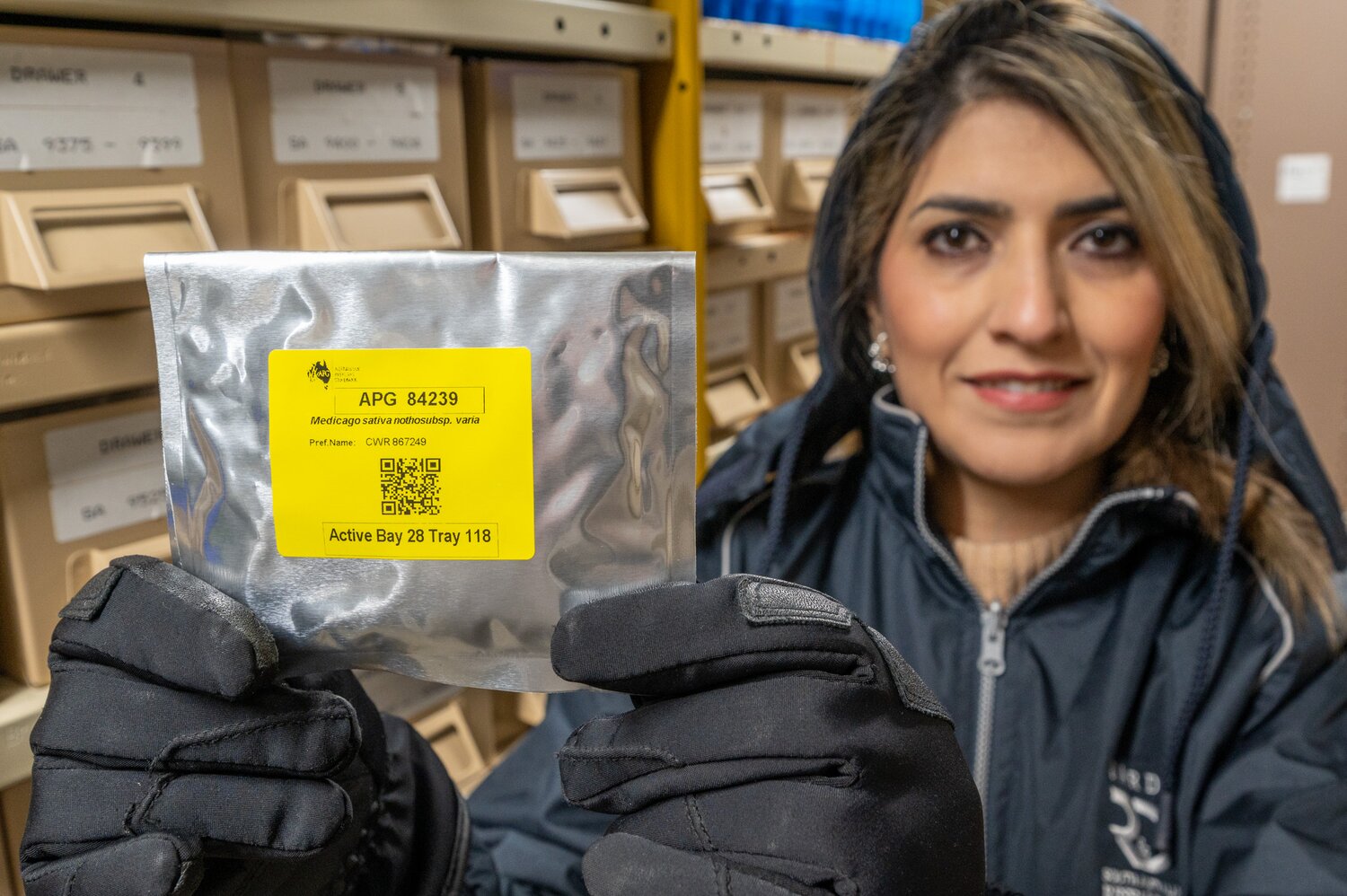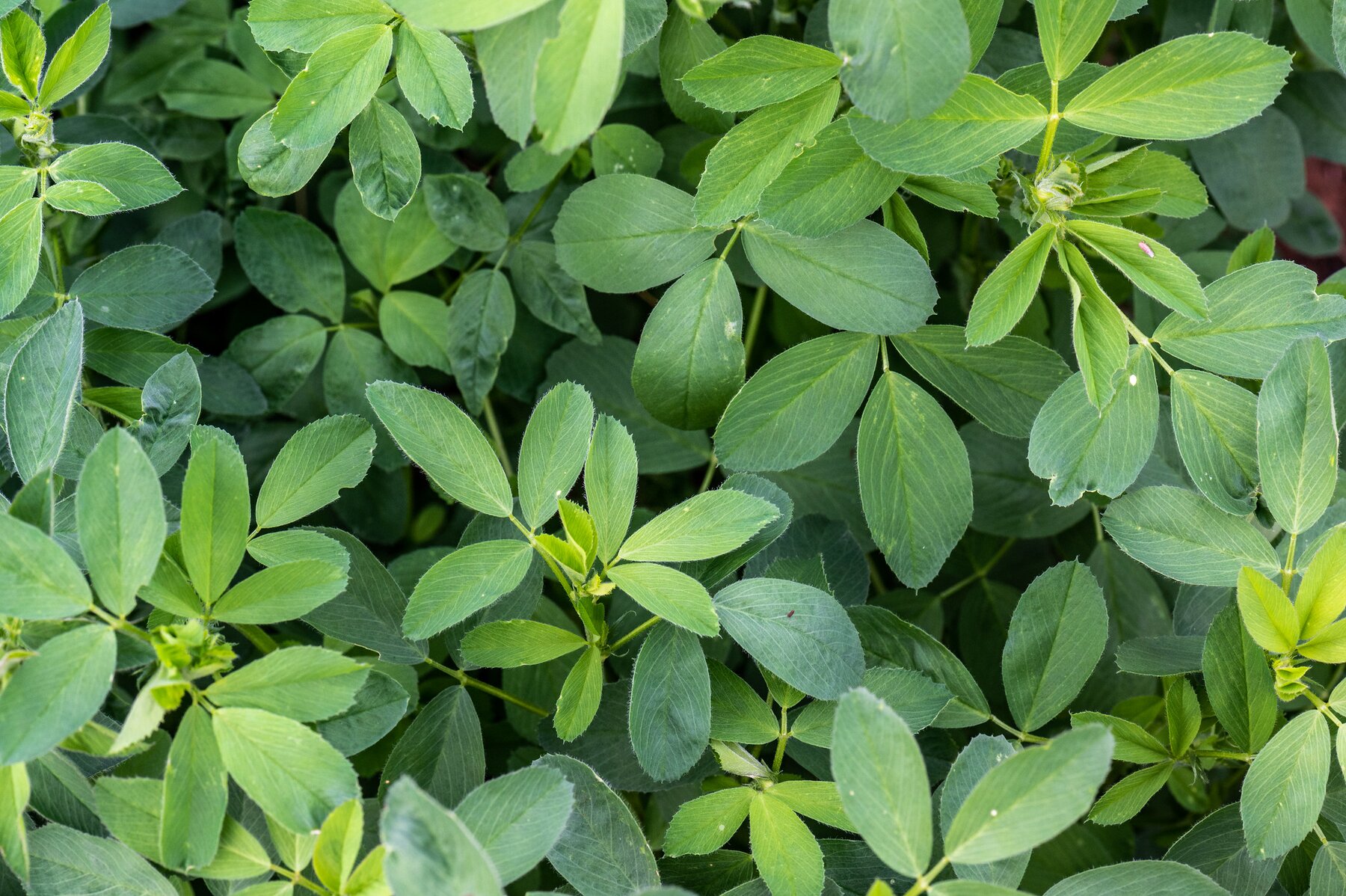Alfalfa
Why alfalfa?
Alfalfa (Medicago sativa L.) is an important and broadly adapted forage crop that is planted for hay, pasture and silage in more than 80 countries on 30-35 million hectares. However, livestock and forage production are being shifted to more marginal, less fertile agricultural soils as the world population increases. Climate change is furthermore projected to further stress alfalfa production in areas where the crop is most important, such as the desert regions of Central Asia and northern Chile. As water becomes scarcer in these regions, the development of improved, drought-tolerant alfalfa varieties will be essential.
What we achieved
Collecting
- 350 seed samples of 20 wild Medicago species were collected in 10 countries: Armenia, Azerbaijan, Chile, Cyprus, Georgia, Italy, Lebanon, Nepal, Pakistan and Portugal.
Pre-breeding and evaluation
- 434 alfalfa crop wild relative (CWR) accessions and pre-breeding lines were evaluated in collaboration with the Australian Pastures Genebank. All evaluation and characterisation data are available at the APG website.
- 54 alfalfa pre-breeding lines that incorporate genes for drought tolerance from alfalfa crop wild relatives were developed and distributed for testing.
- Pre-breeding lines were shared with stakeholders in Australia, China, Chile, India, Tunisia, the United States of America and the United Arab Emirates.
- Adapted varieties of alfalfa incorporating traits from wild relatives and improved agronomy practices introduced to smallholder and subsistence farmers in Chile, China and Kazakhstan.
- Promising pre-breeders lines have been conserved in the Australian Pastures Genebank and are available to users through SMTA.

Project partners
Collecting
- Armenian Botanical Society, Yerevan, Armenia
- Genetic Resources Institute, Azerbaijan National Academy of Sciences, Baku, Azerbaijan
- Instituto de Investigaciones Agropecuarias, La Cruz, Chile
- Agricultural Research Institute, Ministry of Agriculture, Natural Resources and Environment, Nicosia, Cyprus
- Institute of Botany, Ilia State University, Tbilisi, Georgia
- National Botanical Garden of Georgia, Tbilisi, Georgia
- Department of Earth and Environmental Sciences, University of Pavia, Italy
- Lebanese Agricultural Research Institute, Rayak, Lebanon
- National Agriculture Genetic Resources Centre, Nepal Agricultural Research Council, Khumaltar, Nepal
- Plant Genetic Resources Program, Bio-Resources Conservation Institute, Islamabad, Pakistan
- Museu Nacional de História Natural e da Ciéncia, Lisbon, Portugal
Pre-breeding and evaluation
Lead Institute: South Australian Research & Development Institute, Adelaide, South Australia, Australia
Partners:
- Instituto Nacional de Innovacion Agraria (INIA), La Cruz, Chile
- Kazakhstan Scientific Research Institute for Agriculture and Plant Growing (KSRIAPG), Almaty, Kazakhstan
- Grassland Research Institute of the Chinese Academy of Agricultural Sciences (GRI/ CAAS), Huhhot, P.R. China
- The University of California, Davis, United States of America

Negar Nikmanesh with 'Medicago sativa' L. subsp. 'varia' (Martyn) Arcang collected in Georgia 2015 as part of the CWR collecting project managed by Royal Botanic Gardens, Kew. Received and regnerated by the Australian Pastures Genebank in 2017. Photo: Michael Major for Crop Trust
Alfalfa key collections, materials and data
Alfalfa collections
- The largest collection of Medicago spp. is conserved at the Australian Pastures Genebank, which holds 29,145 accessions (seed lines) of alfalfa and its crop wild relatives. The Western Regional Plant Introduction Station, United States Department of Agriculture-Agricultural Research Service, Washington State University, USA, also holds a significant collection.
- Of the 350 seed samples of wild Medicago species collected, 339 samples are conserved in the Millennium Seed Bank (December 2021) and 133 samples are safety duplicated at the Global Seed Vault, Svalbard (December 2021).
- 230 out of 260 accessions evaluated in the Crop Trust alfalfa project have been safety duplicated at the Global Seed Vault, Svalbard.
- The Genesys PGR database also includes information about alfalfa accessions in genebanks worldwide and provides tools for filtering accession lists based on the climate of their collection origins.
Pre-breeding materials
- All pre-breeding materials are conserved in the Australian Pastures Genebank.
Data
- All data from the CWR alfalfa pre-breeding and evaluation projects are available in the Germinate CWR alfalfa database and the Australian Pastures Genebank website.
Alfalfa stories
Crop Trust stories
- Crop Science Honors Research on Crop Wild Relatives. https://www.croptrust.org/news-events/news/crop-science-honors-research-on-crop-wild-relatives/. 7 October 2022.
-
Crop Science Special Issue Shows Why Crops Need to Get Wild. https://www.croptrust.org/news-events/news/crop-science-special-issue-shows-why-crops-need-to-get-wild/. 25 January 2021.
-
Greener Grows the Alfalfa in Chile. https://www.croptrust.org/news-events/news/greener-grows-the-alfalfa-in-chile/. 19 August 2021.
-
Honeybees sweeten the deal for Kazakhstani alfalfa farmers. https://www.cwrdiversity.org/honeybees-sweeten-the-deal-for-kazakhstani-alfalfa-farmers/. Published 18 June 2021.
-
Five Standout Messages from “Into the Wild” at GLF Climate. https://www.croptrust.org/news-events/news/five-standout-messages-from-into-the-wild-at-glf-climate/. 23 November 2021.
-
New alfalfa varieties take root. https://www.croptrust.org/blog/an-alfalfa-that-loves-the-cold/. Published 7 May 2020.
-
Patagonian Farmers Welcome Climate-Resistant Alfalfa. https://www.croptrust.org/blog/patagonian-farmers-welcome-climate-resistant-alfalfa/. Published 14 July 2020.
-
In search of the elusive sea medick on Georgia’s Black Sea coast. https://www.cwrdiversity.org/sea-medick/. Published 25 September 2017.
-
Alfalfa, Queen of Forages: Reconquering the Grasslands of Inner Mongolia. https://www.cwrdiversity.org/alfalfa-queen-of-forages-reconquering-the-grasslands-of-inner-mongolia/. Published 12 December 2018.
-
Alfalfa pre-breeding: Spotlight on Alan Humphries. https://www.croptrust.org/spotlight/alan-humphries/. Published 5 September 2018.
Partner stories
- SA drought tolerant lucerne program to feed the world. https://www.graincentral.com/cropping/drought-tolerant-lucerne-program-to-feed-the-world/. Published 11 February 2020.
- Can Crops’ Wild Relatives Save Troubled Agriculture? https://daily.jstor.org/can-crops-wild-relatives-save-troubled-agriculture/. Published 10 December 2019
- Alfalfa, Queen of Forages: Reconquering the Grasslands of Inner Mongolia. https://foodtank.com/news/2018/12/alfalfa-queen-of-forages-reconquering-the-grasslands-of-inner-mongolia/. Published December 2018.
Relevant publications
-
Ovalle, C., Espinoza, S., Barahona, V., Gerding, M., Humphries, A., del Pozoet, A. 2015. Lucerne and other perennial legumes provide new options for rainfed livestock production in the Mediterranean-climate region of Chile. Ciencia Investigacion Agraria 42: 465−478.
- Wang, Y., Yu, L., Li, J., Sun, J., Xie, J. 2016. Effects of chilling stress on the root characteristics of 5 alfalfa varieties. Acta Agrestia Sinica 1: 101−106.
- Wang, Y., W., Li, J., Yu, L., Yuan, T., Yang, Z. 2017. The morphology indexes of different alfalfa cultivars in northwest of HeBei. Heilongjiang Animal Science and Veterinary Medicine 8: 175−176, 298−299.
- Meiirman, G.T. 2017. On the use of wild species in recurrent selection for enhancing the adaptability of cultural varieties of alfalfa [in Russian]. Biotechnology, Genetics and Plant Breeding 29−30: 48−50.
- del Pozo, A., Ovalle, C., Espinoza, S., Barahon, V., Gerding,. M., Humphries, A. 2017. Water relations and use-efficiency, plant survival and productivity of nine alfalfa (Medicago sativa L.) cultivars in dryland Mediterranean conditions. Journal of Agronomy 84: 16−22.
- Espinoza, S., Barahona, V. 2017. Nueva alternativa para producción de forraje en períodos de escasez alfalfa en condiciones de secano mediterráneo. Ficha Técnica INIA Raihuen Praderas 3.
- Galiolla, M., Serik, K., Sakysh, Y., Serik, A., Saltanat, T. 2017. Results of selection studies of alfalfa based on inbred lines. Agricultural Science and Technology A 7: 309−316.
- Sun, J., Yu, L., Zhao, J., Liu, H., Zhang, Y. 2017. Effects of heterogeneous root zone salinity on plant growth and ion characteristic in alfalfa. Scientia Agricultura Sinica 50(22): 4299–4306.
- Humphries, A., Ovalle, C., del Pozo, A., Inostroza, L., Barahona, V., Ivelic-Saez, J., Yu, L., Yerzhanova, S., Meiirman, G. Abayev, S., Brummer, E., Hughes, S., Bingham, E., Kilian, B. 2018. Introgression of alfalfa crop wild relatives for climate change adaptation. In: Basigalup, D., del Carmen Spada, M., Odorizzi, A., Arolfo, V. (eds). Proceedings. Second World Alfalfa Congress, Cordoba, Argentina. 11–14 November, 2018. Buenos Aires, Argentina: Instituto Nacional de Tecnología Agropecuaria (INTA). pp. 72–76.
- Ji, R., Yu, L., Bai, S. 2018. Effects of colchicine on chromosome doubling of Medicago sativa L. cv. Jinda. Journal of Northwest A & F University – Natural Science Edition 46(1):103–110.
- Wang Y.T., Yu L.Q., Yang Z.M., Wang C.J. Yan L.L., Ge J., Dong X.F. 2018. Germination characteristics of 10 alfalfa varieties under Na2CO3 stress. Pratacultural Science 35(6): 1443–1450.
- Sun, JuanJuan, A, LaMuSi, Zhao, JinMei, Xue, YanLin, Yu, LinQing, Yu, Zhu, Zhang, YingJun. 2019. Analysis of amino acid composition and six native alfalfa cultivars. Scientia Agricultura Sinica 52(13): 2359–2367.
- Inostroza, L., Espinoza, S., Barahona, V., Gerding, M., Humphries, A., del Pozo, A., Ovalle, C. 2020. Phenotypic diversity and productivity of Medicago sativa subspecies from drought-prone environments in Mediterranean type climates. Plants 10(5): 862. https://doi.org/10.3390/plants10050862
- Toktarbekova, S.T. kyzy, Meiirman, G.T., Yerzhanova, S.T., Abayev, S.S., Umbetov, A.K. 2020. Productivity of the green mass of new alfalfa cultivars depending on the effect of macro- and microfertilizers on various phosphorous backgrounds. Journal of Ecological Engineering, 21(2): 57–62.
- Inostroza, L., Ovalle, C., Del Pozo, A., Espinoza, S., Viviana, B., Gerding, M., Humphries, A. 2019. High-throughput phenotyping based on canopy reflectance and RGB-images for selecting drought tolerant alfalfa in rainfed Mediterranean environments. In: Huguenin-Elie, O., Studer, B., Kölliker, R., Reheul, D., Probo, M., Barre, P., Feuerstein, U., Roldán-Ruiz, I., Mariotte, P., Hopkins, A. (eds). Improving sown grasslands through breeding and management. Gatersleben, Germany: European Association for Research on Plant Breeding. pp 327–329.
- Humphries, A.W., Ovalle, C., Hughes, S., del Pozo, A., Inostroza, L., Barahona, V., Yu, L., Yerzhanova, S., Rowe, T., Hill, J., Meiirman, G., Abayev, S., Brummer, E.C., Peck, D.M., Toktarbekova, S., Kalibayev, B., Espinoza, S., Ivelic-Saez, J., Bingham, E., Small, E., Kilian, B. 2021. Characterization and pre-breeding of diverse alfalfa wild relatives originating from drought-stressed environments. Crop Science 61: :69–88.
- Innes, L.A., Denton, M.D., Dundas, I.S., Peck, D.M., Humphries, A.W. 2021. The effect of ploidy number on vigor, productivity, and potential adaptation to climate change in annual Medicago species. Crop Science: 61: 89–103.

